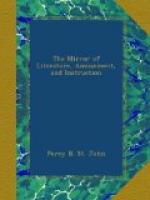THE TULIP TREE.
This tree is now in bloom. It is a native of North America, where it is vulgarly called the poplar. The first which produced blossoms in this country, is said to have been at the Earl of Peterborough’s, at Parson’s Green, near Fulham. In 1688 this tree was cultivated by Bishop Compton at Fulham, who introduced a great number of new plants from North America. At Waltham Abbey, is a tulip tree, supposed to be the largest in England. The leaves of the tulip tree are very curious, and appear as if cut off with scissors. The flowers, though not glaring, are singularly beautiful, resembling a small tulip, variegated with green, yellow and orange, standing solitary at the ends of the branches. I saw one of these curious trees in full bloom a few days since between Edmonton and Enfield.
P.T.W.
* * * * *
CHANGES DURING THE MATURATION OF FRUIT.
The sap is changed into a viscid fluid, which circulates under the bark: this is called cambium. When it is too abundant it is effused, part of its water evaporates, and it becomes gum. If the vital circle is not interrupted, the fluid traverses the branches, and the peduncle arrives in the ovary, and constitutes the pericarp. In this passage it is partly modified: it appropriates to itself the oxygen of its water of composition; hence the malic, citric, and tartaric acids. As the fruit becomes developed, the pellicle thins, becomes transparent, and allows both light and heat to exercise a more marked influence. It is during this period that maturation commences. The acids react on the cambium, which flows into the fruit, and, aided by the increased temperature, convert it into saccharine matter; at the same time they disappear, being saturated with gelatine, when maturation is complete.—London Medical and Surgical Journal.
We may here observe that in a recent paper, by Mr. J. Williams, in the Transactions of the Horticultural Society, the cause of apples becoming russet is attributed to the alternating temperature, light, shade, dryness, and moisture, which occur many times in the course of a day, when July or August is showery. Continued rain, preceded and followed by a cloudy sky, does not seem to produce the same effect, but the sudden, intense light which commonly succeeds a shower at the time the fruit is wet, injures the skin, and occasions small cracks, like the network upon a melon.
* * * * *




